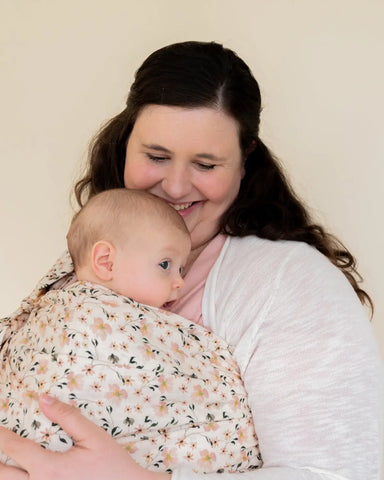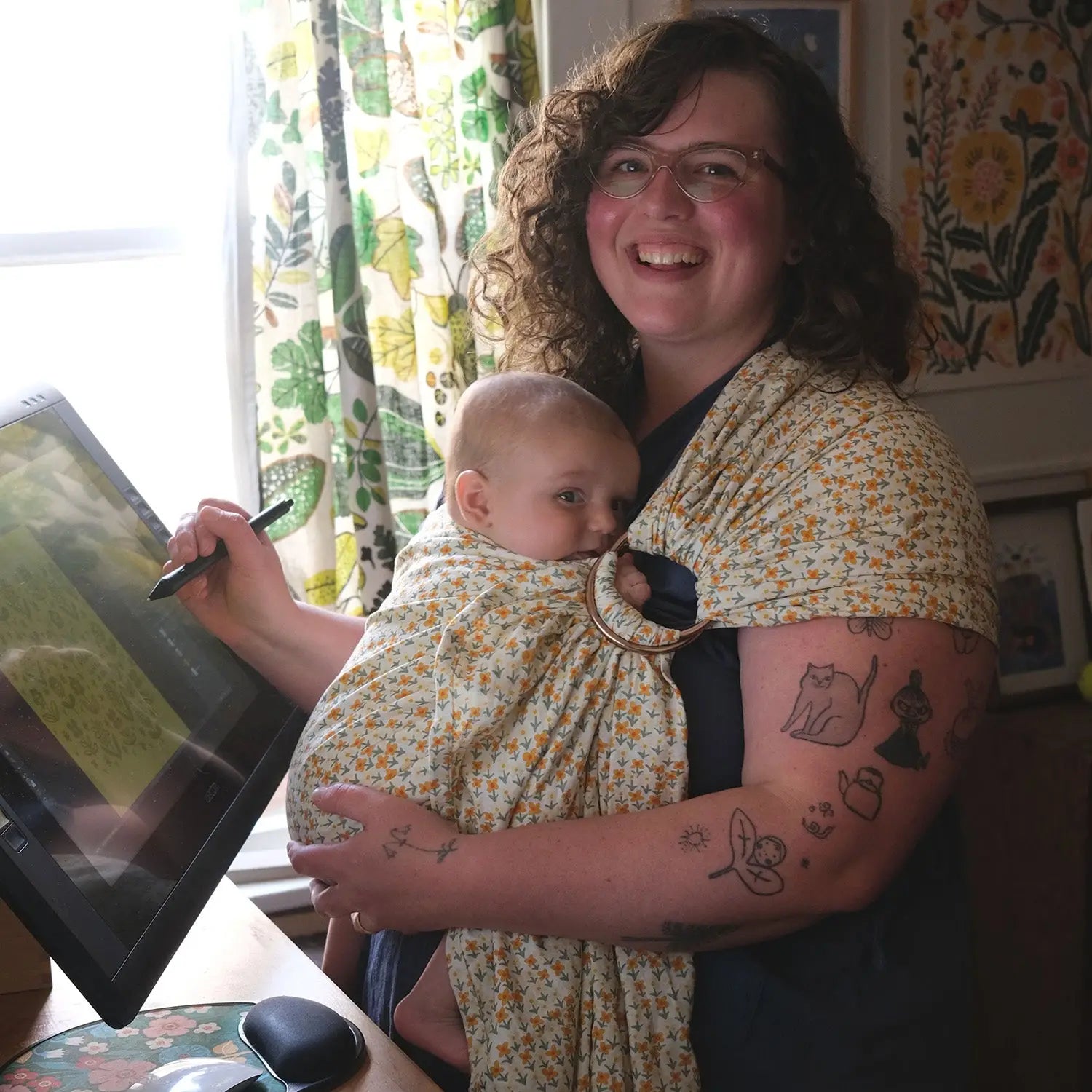How to Use a Ring Sling
Here are our top tips for how to use a ring sling:
- Bring baby in the ring sling when they are happy and content.
- When getting the ring sling on your body and ready for your baby, start with a smaller pouch than you think you'll need. Less adjusting of the ring sling = happier baby!
- Once in the ring sling, ensure you can easily see baby's airway, at all times, that they are close enough for you to kiss their head, and that their spine and neck are both well supported.
- If you or baby become frustrated or uncomfortable, take a break and come back and try again! Practice makes perfect and it’ll get easier with time.
- For more tips, check out our ring sling tutorials on YouTube, here!

Here are some answers to our most frequently asked questions about how to use a ring sling.
Which ring sling carry is best for newborns: legs in or legs out? Which carry is best for bigger kids and toddlers: front or hip carry?
When using a ring sling with a newborn you can use two carries: tummy to tummy with legs in, (commonly known as a "newborn carry") and tummy to tummy with legs out (known as a "front carry”). There isn’t a "best carry" with a newborn in a ring sling, as it’s totally dependent on you and your babe! Some babies love to be worn in the ring sling with their legs in and some prefer legs out right away. Try both options and see which feels better for the both of you! TIP: If your baby is placed in the ring sling with their legs in and you find they are trying to straighten their legs -or “stand up”- while in the fabric pocket of the ring sling, they likely will be more comfortable with the legs out carry. (Learn how to use your ring sling with a "legs out" carry with our tutorial here!)
When carrying a toddler you can carry them centered on your chest, or to the side on your hip. Having proper head control is important when carrying them on your hip since they need to be able to support their own head. Hip carry is a great way to let those curious big kids watch the world around them while staying safe and near their caregiver. Front carry is perfect for those kids who love to snuggle up close and enjoy being held or in a safe place to rest. Whether you do a front or hip carry, your baby will enjoy all the benefits babywearing can bring them.
What is the weight requirement for a ring sling?
All of our ring slings are safety tested for use with infants and toddlers weighing 8 to 35 pounds. If you would like to use your ring sling before your baby is 8 pounds, seek advice from your healthcare provider!

Which ring sling fabric is best?
The best ring sling will be the one you're most comfortable using! All of our fabrics are pre-washed and soft enough for your newborn and sturdy enough for your toddler. If you’re new to using a ring sling, you may prefer to use a ring sling made with a single layer of fabric like our linen or linen/cotton blend, as it will be easier to learn with.
Is there a time limit for using a ring sling?
There’s no time limit! You can wear your baby in a ring sling as long as you’re both comfortable and happy. In fact, baby-wearing for three hours a day significantly reduces newborn crying — 43 percent overall and 51 percent at night. So hold that baby!

I’m plus sized and terrified of using a ring sling with my newborn and hurting my baby's legs.
You won’t hurt your baby! Your little one will let you know if they feel uncomfortable. If you are concerned that their legs are too stretched, you can center them over the breast farthest from the rings, rather than centered on the middle of your chest. Feel free to send us an email for personalized help!
How do you keep your newborn’s feet from turning their legs in while in the ring sling?
It’s OK if their feet turn! Take a look at your baby’s natural positioning when you hold them on your chest: this is the position you want them to assume when they are in the ring sling, with their legs in. If you’re doing a legs out carry with a newborn, it’s absolutely fine for their legs to turn in a bit, instead of out, like older babies.What do I do if the rings are too close to baby/won’t stay in the corsage position?
If your rings fall while you are adjusting your ring sling, we have two recommendations. First, start with a smaller pouch for your baby so that you don’t have as much adjusting to do once your baby is in the ring sling. Second, if your rings still fall with a smaller pouch, try placing them higher up, even on the top of your shoulder, before getting baby into the ring sling. If you are still struggling with getting a good fit with your ring sling, you can always send us an email and we are happy to provide personalized help!

How tight should the ring sling be?
Your sling should be snug over both you and your baby. You should be able to run a finger across both the top and bottom (if legs are out) seams, easily. You’ll also want the fabric to be as smooth as possible over baby’s back, as that will offer the most support for both of you.How do you keep the M shape when their legs don’t hang out?
In a newborn carry in your ring sling, the "M position" is not always necessary. Some newborns prefer to tuck their feet under their hips, while others may choose to do the “froggy position”, where their legs fall to either side of their body. Both of these positions are suitable and safe. The main positioning to look for when using a newborn carry is to make sure baby is not sitting on their feet, keeping baby close enough to kiss with their airway clear, and making sure their back is well supported so they aren't slouching to one side.

Benefits of Ring Slings and Babywearing Our Newborns
- Great for traveling. Our love of being close to our babes, combined with the desire (and quite frankly, the need!) to be free to move easily, is what makes ring slings so essential to our everyday lives as caregivers. Ring slings are quick and simple to use, while also being easy to clean. (Both of which are invaluable when dealing with babies and toddlers!)
- Research shows babywearing can decrease the risk of postpartum depression. A recent Canadian study found that mothers providing daily skin-to-skin contact to their newborn had significantly lower scores on the depression scales when their infants were one week, and marginally significantly lower scores when the infants were one month. Babywearing your newborn in a ring sling keeps them close to your body and allows for extended skin-to-skin contact—with the added benefit of getting to hold your baby hands-free.
- Limits people touching your baby. While using a ring sling, your babe is kept close to you which can help prevent unwanted touching!
- Benefits cognitive and social development. Babies who are worn are able to see what their parents see, hear what their parents hear or say, and are overall more involved in their parents' everyday lives. Also, when babies spend less time crying, they in turn spend more time learning and interacting with their environment. Having your baby so close to you allows you to respond to their cues and touch them more. These can contribute to enhanced learning and cognitive development, and overall wellbeing.

Using a ring sling for the first time can be a little intimidating, but the most important thing to remember is to keep baby safe and happy. It might take some time to get it right, or feel comfortable putting on the ring sling quickly in the midst of daily chaos. But we hope these tips help you to feel more confident in doing so! As always, feel free to reach out to us if you need or want some one-on-one assistance. Babywearing should be a fun experience that helps you accomplish daily tasks; whether that's getting some chores done, running errands, or just spending some bonding time getting to know your new babe.
Looking for information on how to use our stretchy baby wraps? Check out our blog post here.


